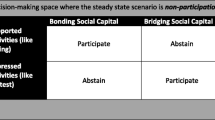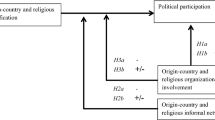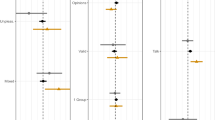Abstract
This study examines whether ethnic organization members have a lower likelihood of community activism than multiethnic organization members as predicted by social capital approaches to collective civic engagement. Community activism is measured by whether the respondent has worked with others in his or her community to solve a problem in the last 12 months. Data come from the 2008 National Asian American Survey, and the sample is limited to five major Asian immigrant groups (the Chinese, Asian Indians, Filipinos, Koreans, and the Vietnamese) for group-specific analyses. Findings suggest that membership in ethnic organizations does not necessarily diminish the probability of community activism: For the Chinese and Asian Indians, members of ethnic organizations have a higher probability of community activism than their non-joiner counterparts. Yet, consistent with the prediction of social capital approaches, there is a significant difference in the probability of community activism between members of multiethnic organizations and non-joiners for all ethnic groups, except for the Vietnamese. Nevertheless, findings show that there is no significant difference in the likelihood of community activism between members of ethnic organizations and those of multiethnic organizations for each ethnic group. Thus, data from the 2008 NAAS fail to provide compelling evidence to support the social capital argument that involvement in ethnic organizations has a significantly weaker effect on collective civic engagement than involvement in multiethnic organizations. This paper concludes with a discussion of the implications of these findings.
Similar content being viewed by others
References
Almond, G. A., & Verba, S. (1963). The civic culture: political attitudes and democracy in five nations. Princeton: Princeton University Press.
Baggetta, M. (2009). Civic opportunities in associations: interpersonal interaction, governance experience and institutional relationships. Social Forces, 88(1), 175–199.
Baldassarri, D., & Diani, M. (2007). The integrative power of civic networks. American Journal of Sociology, 113(3), 735–780.
Beyerlein, K., & Hipp, J. R. (2006). From pews to participation: the effect of congregation activity and context on bridging civic engagement. Social Problems, 53(1), 97–117.
Bloemraad, I. (2006). Becoming a citizen: incorporating immigrants and refugees in the United States and Canada. Berkeley: University of California Press.
Brettell, C., & Reed-Danahay, D. (2012). Civic engagements: the citizenship practices of Indian and Vietnamese immigrants. Stanford: Stanford University Press.
Chung, A. Y. (2007). Legacies of struggle: conflict and cooperation in Korean American politics. Stanford: Stanford University Press.
Diani, M., & McAdam, D. (Eds.). (2003). Social movements and networks: relational approaches to collective action. New York: Oxford University Press.
Ebert, K., & Okamoto, D. G. (2013). Social citizenship, integration and collective action: immigrant civic engagement in the United States. Social Forces, 91(4), 1267–1292.
Ecklund, E. H., & Park, J. Z. (2005). Asian American community participation and religion: civic “model minorities?”. Journal of Asian American Studies, 8(1), 1–21.
Eckstein, S. (2001). Community as gift-giving: collectivistic roots of volunteerism. American Sociological Review, 66(6), 829–851.
Erickson, B. H., & Nosanchuk, T. A. (1990). How an apolitical association politicizes. Canadian Review of Sociology and Anthropology, 27(2), 206–219.
Fennema, M., & Tillie, J. (1999). Political participation and political trust in Amsterdam: civic communities and ethnic networks. Journal of Ethnic and Migration Studies, 25(4), 703–726.
Granovetter, M. S. (1973). The strength of weak ties. American Journal of Sociology, 78(6), 1360–1380.
Granovetter, M. S. (1983). The strength of weak ties: a network theory revisited. Sociological Theory, 1, 201–233.
Grieco, E. M., Acosta, Y. D., de la Cruz, G. P., Gambino, C., Gryn, T., Larsen, L. J., & Walters, N. P. (2012). The foreign-born population in the United States: 2010 (report no. ACS-19). Washington: U.S. Census Bureau.
Hagan, J. M. (1998). Social networks, gender, and immigrant incorporation: resources and constraints. American Sociological Review, 63(1), 55–67.
Hechter, M., Friedman, D., & Appelbaum, M. (1982). A theory of ethnic collective action. International Migration Review, 16(2), 412–434.
Hirschman, C. (2004). The role of religion in the origins and adaptation of immigrant groups in the United States. International Migration Review, 38(3), 1206–1233.
Knoke, D. (1982). Political mobilization by voluntary associations. Journal of Political and Military Sociology, 10(3), 171–182.
Laglagaron, L., Rodríguez, C., Silver, A., & Thanasombat, S. (2008). Regulating immigration at the state level: highlights from the database of 2007 state immigration legislation and the methodology. Washington: Migration Policy Institute.
Levitt, P. (2008). Religion as a path to civic engagement. Ethnic and Racial Studies, 31(4), 766–791.
Lien, P.-T., Conway, M. M., & Wong, J. (2004). The politics of Asian America: diversity and community. New York: Routledge.
Lim, C. (2010). Mobilizing on the margin: how does interpersonal recruitment affect citizen participation in politics. Social Science Research, 39(2), 341–355.
Massey, D. S., Alarcón, R., Durand, J., & González, H. (1987). Return to Aztlan: the social process of international migration from western Mexico. Berkeley: University of California Press.
McAdam, D., & Paulsen, R. (1993). Specifying the relationship between social ties and activism. American Journal of Sociology, 99(3), 640–667.
Min, P. G. (2008). Ethnic solidarity for economic survival: Korean greengrocers in New York City. New York: Russell Sage Foundation.
Mora, G. C. (2013) Religion and the organizational context of immigrant civic engagement: Mexican Catholicism in the USA. Ethnic and Racial Studies 36(11), 1647–1665.
Okamoto, D. G. (2006). Institutional panethnicity: boundary formation in Asian-American organizing. Social Forces, 85(1), 1–25.
Okamoto, D. G., & Ebert, K. (2010). Beyond the ballot: immigrant collective action in gateways and new destinations in the United States. Social Problems, 57(4), 529–558.
Olzak, S. (1992). The dynamics of ethnic competition and conflict. Stanford: Stanford University Press.
Paxton, P. (2002). Social capital and democracy: an interdependent relationship. American Sociological Review, 67(2), 254–277.
Portes, A., Escobar, C., & Arana, R. (2008). Bridging the gap: transnational and ethnic organizations in the political incorporation of immigrants in the United States. Ethnic and Racial Studies, 31(6), 1056–1090.
Putnam, R. D. (1993). Making democracy work: civic tradition in modern Italy. Princeton: Princeton University Press.
Putnam, R. D. (1995). Bowling alone: America’s declining social capital. Journal of Democracy, 6(1), 65–78.
Putnam, R. D. (2000). Bowling alone: the collapse and revival of American community. New York: Simon & Schuster.
Rogers, D. L., Bultena, G. L., & Barb, K. H. (1975). Voluntary association membership and political participation: an exploration of the mobilization hypothesis. Sociological Quarterly, 16(3), 305–318.
Rosenstone, S. J., & Hansen, J. M. (1993). Mobilization, participation, and democracy in America. New York: Macmillan.
Rubin, D. B. (1987). Multiple imputation for nonresponse in surveys. New York: Wiley.
Sampson, R. J., McAdam, D., MacIndoe, H., & Weffer, S. (2005). Civil society reconsidered. American Journal of Sociology, 111(3), 673–714.
Singer, A., Hardwick, S. W., & Brettell, C. B. (Eds.). (2008). Twenty-first century gateways: immigrant incorporation in suburban America. Washington: Brookings Institution Press.
Skocpol, T., & Fiorina, M. P. (Eds.). (1999). Civic engagement in American democracy. New York: Russell Sage Foundation.
Son, J., & Lin, N. (2007). Social capital and civic action: a network-based approach. Social Science Research, 37, 330–349.
Stolle, D., & Rochon, T. (1998). Are all associations alike? Member diversity, associational type, and the creation of social capital. American Behavioral Scientist, 42(1), 47–65.
Strömblad, P., & Adman, P. (2010). Political integration through ethnic or nonethnic voluntary associations? Political Research Quarterly, 63(4), 721–730.
Swaroop, S., & Morenoff, J. D. (2006). Building community: the neighborhood context of social organization. Social Forces, 84(3), 1665–1696.
Teorell, J. (2003). Linking social capital to political participation: voluntary associations and networks of recruitment in Sweden. Scandinavian Political Studies, 26(1), 49–66.
Uslaner, E. M., & Conley, R. S. (2003). Civic engagement and particularized trust: the ties that bind people to their ethnic communities. American Politics Research, 31(4), 331–360.
Verba, S., & Nie, N. H. (1972). Participation in America: political democracy and social equality. New York: Harper & Row.
Verba, S., Schlozman, K. L., & Brady, H. E. (1995). Voice and equality: civic voluntarism in American politics. Cambridge: Harvard University Press.
Walker, E. T. (2008). Contingent pathways from joiner to activist: the indirect effect of participation in voluntary associations on civic engagement. Sociological Forum, 23(1), 116–143.
Wong, J. S. (2006). Democracy’s promise: immigrants and American civic institutions. Ann Arbor: University of Michigan Press.
Wong, J. S., Ramakrishnan, K., Lee, T., & Junn, J. (2011). Asian American political participation. New York: Russell Sage Foundation.
Wuthnow, R. (1998). Loose connections: joining together in America’s fragmented communities. Cambridge: Harvard University Press.
Wuthnow, R. (1999). Mobilizing civic engagement: the changing impact of religious involvement. In T. Skocpol & M. P. Fiorina (Eds.), Civic engagement in American democracy (pp. 331–363). New York: Russell Sage Foundation.
Wuthnow, R. (2002). Religious involvement and status-bridging social capital. Journal for the Scientific Study of Religion, 41(4), 669–684.
Zukin, C., Keeter, S., Andolina, M., Jenkins, K., & Delli Carpini, M. X. (2006). A new engagement: political participation, civic life, and the changing American citizen. New York: Oxford University Press.
Author information
Authors and Affiliations
Corresponding author
Rights and permissions
About this article
Cite this article
Kim, C. Involvement in Ethnic Organizations and Community Activism Among Asian Immigrants in the United States. Int. Migration & Integration 19, 315–338 (2018). https://doi.org/10.1007/s12134-018-0550-8
Published:
Issue Date:
DOI: https://doi.org/10.1007/s12134-018-0550-8




